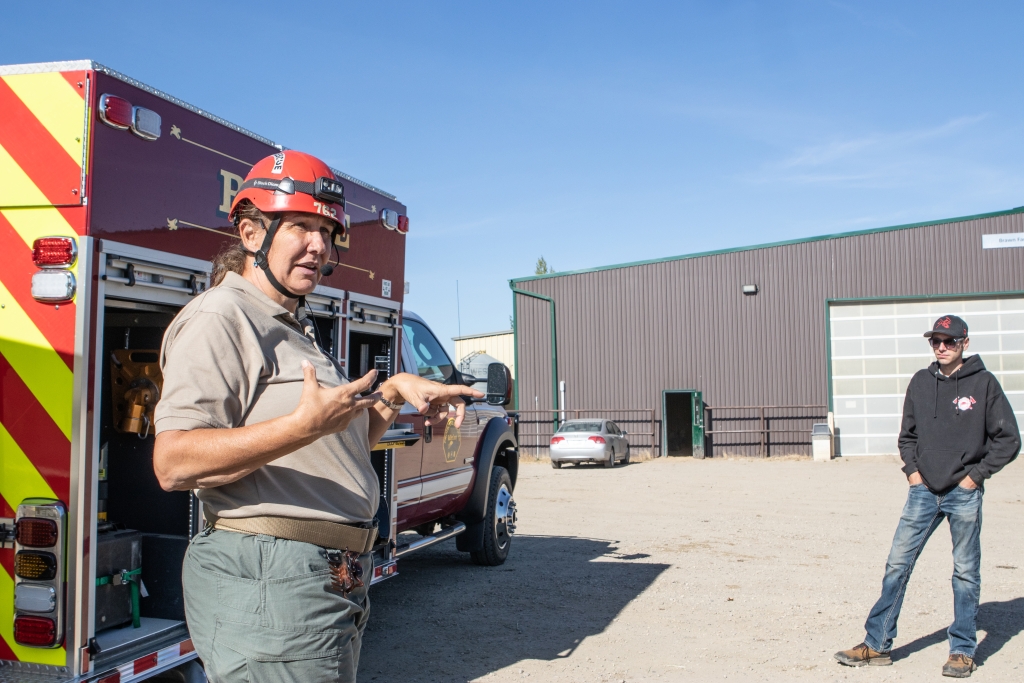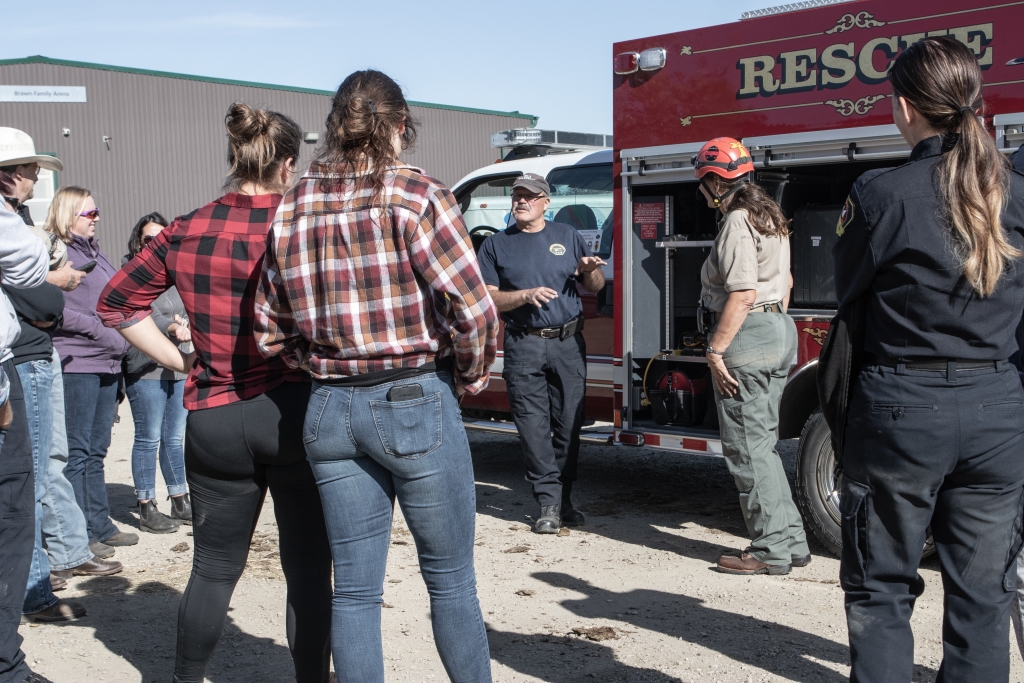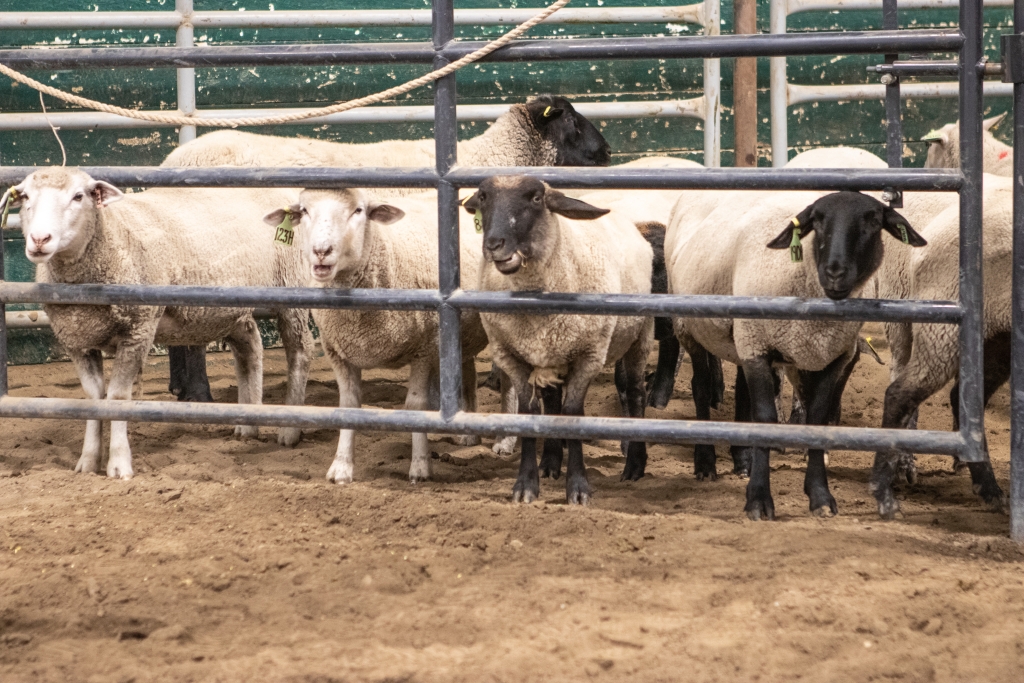

Nervous and injured animals add multiple layers of complexity and danger in any emergency, whether it be fire, flood or vehicle collision.
The skills and tools available for people responding to an emergency will directly affect the outcome, says instructor Rebecca Gimenez Husted, who brought Technical Large Animal Emergency Rescue’s travelling road show to Olds College early in October, hosted by Alberta Farm Animal Care. The two-day course was specifically geared to horse rescue, but provided valuable information for preventing and managing emergencies with all types of farm animals.
A well planned and coordinated response can limit further injury to people and animals, says Husted. On the other hand, a hurried and poorly managed rescue attempt can trigger a catastrophe.
Stories abound of well-meaning people whose first instinct is to get surviving animals out of the trailer or box, only to see them run into traffic and cause more mayhem, says veterinarian Melissa Moggy, extension coordinator for AFAC. Cows escaping a damaged liner most likely have never seen vehicle traffic before, with predictable results.
“I think everyone has experienced those situations, because the thought process is, ‘We need to get them out, we need to get them safe,’” she said.
“During the course, we learned how we have to work as one. We have to work together. Everyone needs to know who’s doing what, so things can go along smoothly. It’s not like having to look after an injured small animal.”
Husted emphasized the importance of keeping animals confined after a vehicle collision to prevent the kind of calamity that escapees can create.
Kevin Brooks, production manager for a commercial hog company in Saskatchewan, described for Prairie Hog Country, a collision scene in which everything went right.
The prairies were still in the depths of winter on the evening of February 2, 2022, when a liner carrying 69 culled sows caught an edge and rolled into the ditch heading east toward Yorkton.
One animal was ejected into the ditch, while the rest remained in the trailer, said Brooks.
Police and fire crews arrived quickly and put out the call for people and equipment to help manage the animals. Firefighters were able to find and acquire a loading chute from a local source. They contained the scene for about an hour, waiting for company farm specialists, including Brooks and veterinarian Jeff Bergermann, a livestock emergency trailer from Humboldt, and a truck and trailer to collect the stranded sows.
No animals died in the crash and almost all were saved. Two were put down because of their injuries, including the one that had been thrown from the trailer. Brooks said emergency medical staff checked the driver out at the scene and found no serious injuries.
Once the specialists had assembled at the site, Brooks and Bergermann put a game plan together to free the sows from the trailer and move them into the second unit.
The most challenging aspect for responders was cutting a door into the trailer to move the animals off, he said. The sows, which had settled down in the trailer and were staying comfortable and warm, were justifiably reluctant to go outside.
Brooks said one of the chief considerations in managing the scene was to be aware of the cold and ensure that all the responders stayed warm and safe.
Husted emphasizes in TLAER training that the first goal in any emergency response is to take care of the people. That includes ensuring that responders wear appropriate personal protection equipment (PPE) and that they do not put themselves at risk. Everything else falls in line after that.
“Once we arrived on scene, with myself and our veterinarian, we put a game plan together,” said Brooks.
“Being that it was animal livestock, the fire team just controlled helping with some of the gates and let us do our process, so our team was the one able to move all the animals.”
Brooks estimated that it took only three and a half hours from the time the specialists arrived on scene until the animals were hauled away and the site cleared.
He was full of praise for the local firefighters and the farm staff who performed a safe and efficient recovery.
“It was a very positive experience. It could not have gone as good without (their) help,” he said.
It normally takes eight hours or more to assess, manage and clear a collision scene when there are livestock involved, Husted told course attendees in Olds.
Although no two emergencies are alike, a basic plan covering each type of emergency, including fire, flood and collision, provides a structure for assessing and executing a response, she said.

Course attendees were split into teams to work through a variety of mock scenarios, with just a few minutes to develop action plans specific to those situations. In all cases, the first set of tasks required calling a veterinarian, establishing a chain of command and assessing the scene.
Livestock emergency trailers, such as those now spotted throughout Alberta and Saskatchewan and in some parts of British Columbia, can be dispatched to provide gear chosen for livestock applications. That gear can include boards, panels, halters, ropes, straps, wood shavings, paddles, disposable coveralls, ladders, fire extinguishers, generators, lights and battery-operated power tools.
Husted and Red Deer County District Fire Chief Darcy Johannson walked course attendees through the array of equipment in the county’s trailer and the rapid response unit that often hauls it. But it’s all meaningless if you don’t know how to use it.
In a live exercise, Husted and Moggy took the class into a horse arena for an introductory course in handling sheep, using a small flock borrowed from the college herd.
The first rule, said Moggy, is that a handler must never grab a sheep by its wool. It’s painful and it damages the meat, she said. She added that the college staff would prefer if the sheep were not touched at all.
Husted advised that sheep, cattle, horses and pigs respond differently and therefore cannot all be handled in the same way, so methods that are effective for moving cattle may be less successful with sheep.
“Moving animals is a people thing, it’s not a sheep thing. Everything you’ve watched on TV is wrong,” Husted said while preparing the class to split into teams and start moving sheep.
She explained an action zone and how humans entering that action zone get immediate attention from the sheep, who becomes more alert in a similar way to how a lone human might respond when approached by a stranger in a dark parking garage.
“These prey animals are very aware of what predators do, so you can’t fake the funk with a prey animal.”
Unlike cattle, which will try to push through or jump an obstacle, sheep and donkeys are more likely to run underneath an obstacle and lift it with their heads and necks, which was swiftly demonstrated by the first pair cut from the flock. Husted encouraged people to keep their hands at their sides and avoid staring at the sheep – a difficult ask of humans who want to move things forward.
“Your whole body language says: ‘I’m going to eat you.’ You don’t think of it that way, but that’s what they think. This is the same rule with cattle, goats, sheep, anything.”
The theory behind the exercise was that a couple of the sheep would be separated from the flock, and then headed down to another pen at the opposite end of the arena. That was the theory. In practice, the two sheep cut from the flock continually circled the herders and charged back toward their pasture mates. Eventually, working together and using a set of portable panels, the teams gathered into one group and created a portable corral that they could walk with the sheep. Under direction of a course mate appointed to take charge, they moved the entire flock to the far end.
Once the flock had gathered in the far pen, Husted appointed a different leader and said no one else should speak. The group was able to walk the sheep back up to the holding pen with none of the escape attempts and shenanigans that had occurred during the first movement.
Regardless of the impact on the attendees’ sheep handling skills, the exercise demonstrated the difficulty of asking people with no livestock experience to move and contain animals on the side of the highway after they’ve been tossed around inside the body of truck box or trailer.
“Cattle, when you pull them off a trailer like that at the side of the Interstate, do you think they’re just going to walk along like that? They’re going to mow you down, so you’ve got to have (the temporary corral or chute) set up ahead of time,” said Husted.
Farm animals are not stupid, but they panic when they get stressed, just like that person in the parking garage, she said.
Additional exercises included an inspection tour of the horse barns and an evaluation of the horse trailers parked outside. Attendees were asked to look for potential hazards in the buildings and vehicles.
Attendees also gained insight into various methods of freeing animals that had become trapped in a variety of different hazards, from mud holes and broken bridges to collapsed barns and cattle gates.
In all cases, incident managers need to assess whether the animal can be saved, and if so, then develop a plan that will involve the least possible risk to the subject as well as the crew conducting the attempt, said Husted. People unfamiliar with large animals are similarly unfamiliar with the risks posed by striking legs and powerful jaws, she said.
She told various stories where humans risked life and limb and spent a fortune in equipment to save an animal only to see it euthanized on site or die from its injuries inflicted in a rescue attempt. Veterinarians play a vital role in assessing the animals’ conditions prior to a rescue attempt, monitoring their vital signs throughout the process, and looking after their injuries afterward. They are also there to caution rescuers against extraction techniques that could cause grievous injuries to the animals and to ensure that after-care is provided to manage for shock and organ failure, which is especially common among horses that have been lying on one side and unable to breathe properly for an extended time.
Husted related one incident in which an owner declined veterinary treatment and monitoring after a horse was freed from a cold, muddy trap. The horse walked away, but later collapsed and died.
Moggy said afterward that the course provided a wealth of valuable information for the people who attended, including a veterinarian, veterinary technicians, rural firefighters and an RCMP livestock investigator. The courses are geared to first responders and livestock handlers and are open to anyone who wishes to attend. The two-day course as offered at Olds is eligible for educational credit where applicable.
Moggy said she was disappointed, however, that the turnout was extremely low at fewer than 20 people.
AFAC and TLAER had planned to bring the course to three communities in Slave Lake on October 1, then move to Olds on the 4th and Taber on the 8th. Sadly, as registration deadlines approached, there were not enough people to fill any of the courses. Slave Lake and Taber were cancelled and those who had registered were invited to go to Olds instead.
Moggy and Husted both said they were not sure why there was not a stronger response, given the value that animal rescue training can have in reducing the risk of death or injury to people during an emergency. Trucks and trailers carry livestock at all times of day and night, and they are not limited to rural roads, said Moggy. That makes every municipality responsible for ensuring that somewhere in their toolkits they have access to the people and gear for effective management of a crisis. However, each municipality has its own ideas about the training it wishes to provide for its volunteers, she said. Notably, while Grande Prairie County sent two of its firefighters to the course – in uniform and supplied with a county pickup truck – a rural county much closer to Olds refused to provide any support for one of its volunteers, who paid the fee himself and attended on his own time.
Moggy said AFAC will continue to find ways to offer the courses and will seek means of demonstrating the benefits to municipalities that provide large animal rescue training and equipment for their emergency services teams.
Husted, an accredited animal health technician with a PhD in animal physiology, is operator and primary instructor for TLAER. The organization was founded in the early 1990s by her first husband, veterinarian Tomas Gimenez. He had become alarmed that, despite the frequency of hurricanes and tropical storms affecting the southeastern states, people operating livestock facilities had not properly prepared for emergencies. Tomas retired from the organization in 2013. Husted and her husband, Mark Husted, live on a small farm in Macon County Georgia. Visit tlaer.org to learn more about TLAER and the supports it offers to first responders.
AFAC is an industry-supported farm animal welfare group, founded to encourage best practices in raising and transporting livestock. AFAC provides a 24-hour emergency line that people can call for help in any emergency involving farm animals. Visit afac.ab.ca to learn more about this group. For help in a crisis, please call the ALERT line, 1-800-506-2273. •
— By Brenda Kossowan





